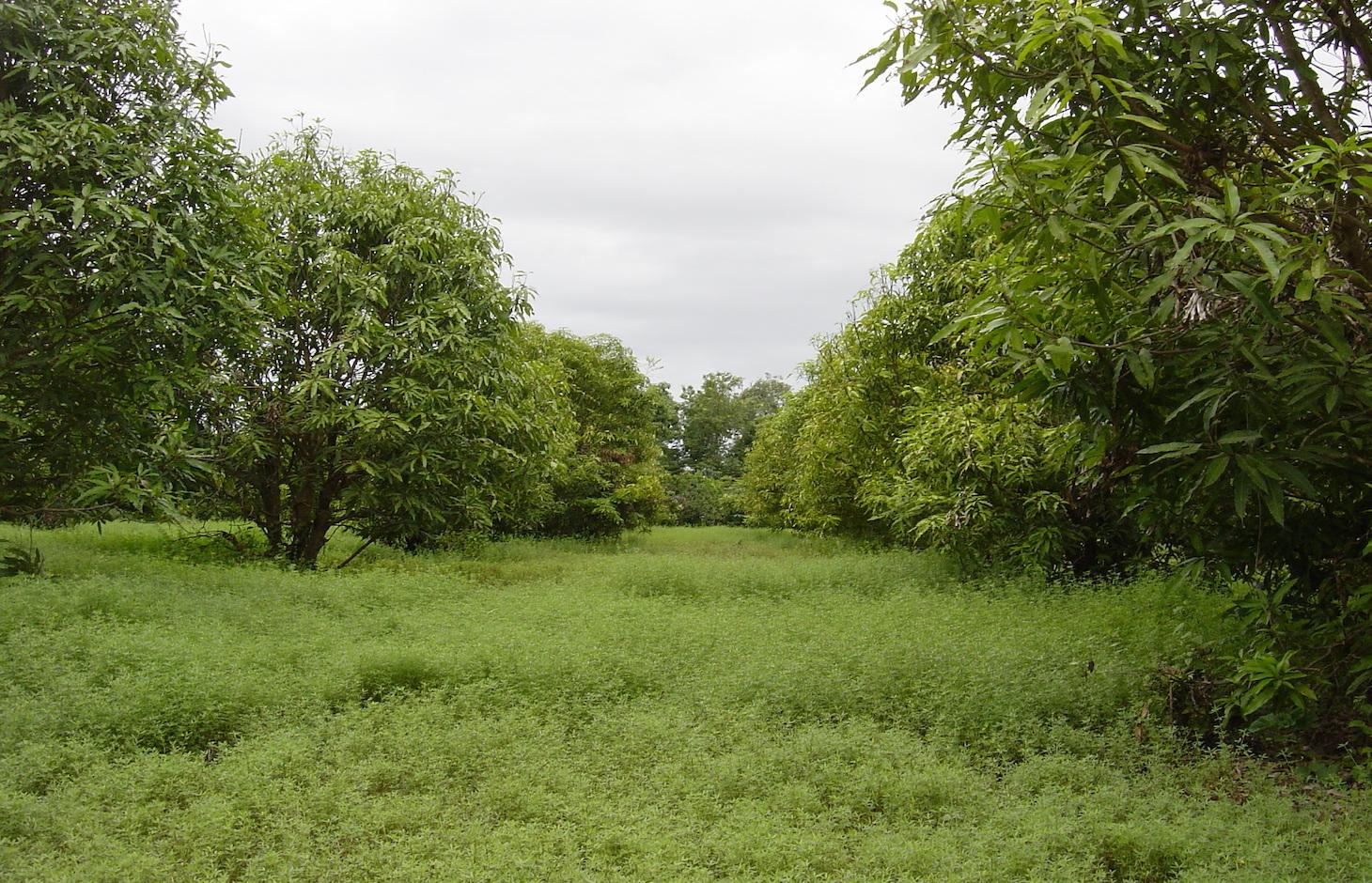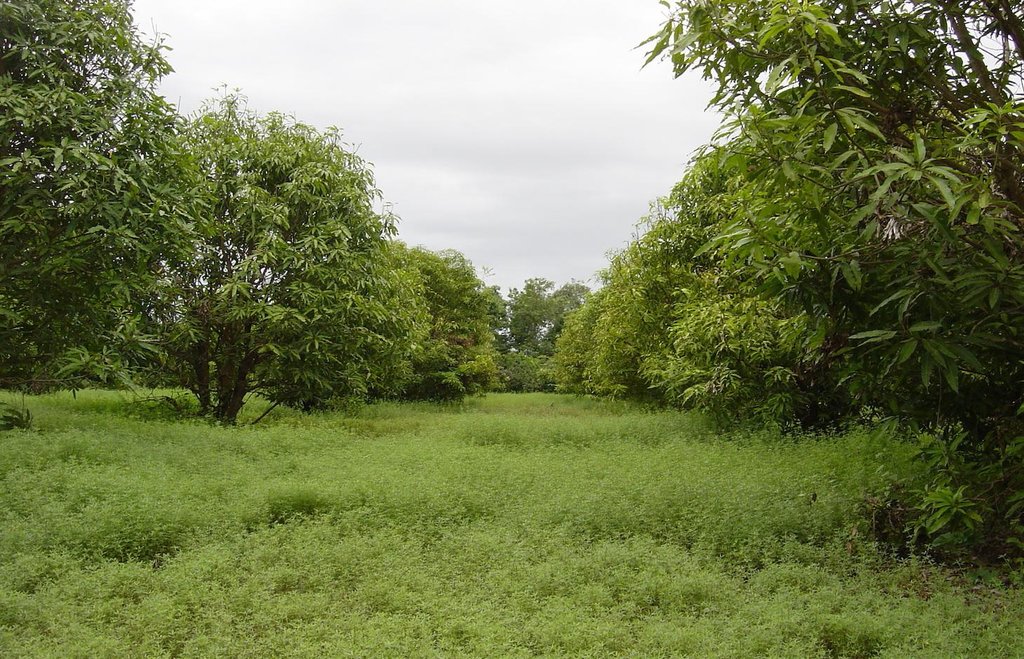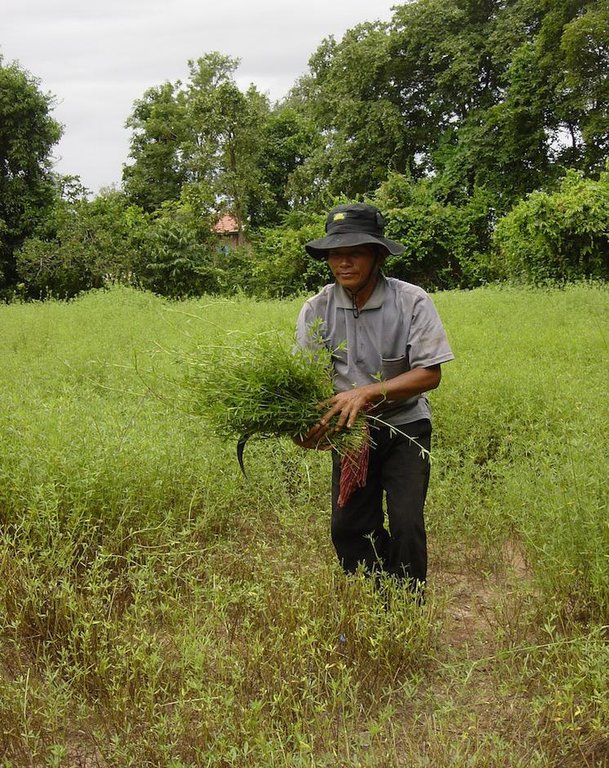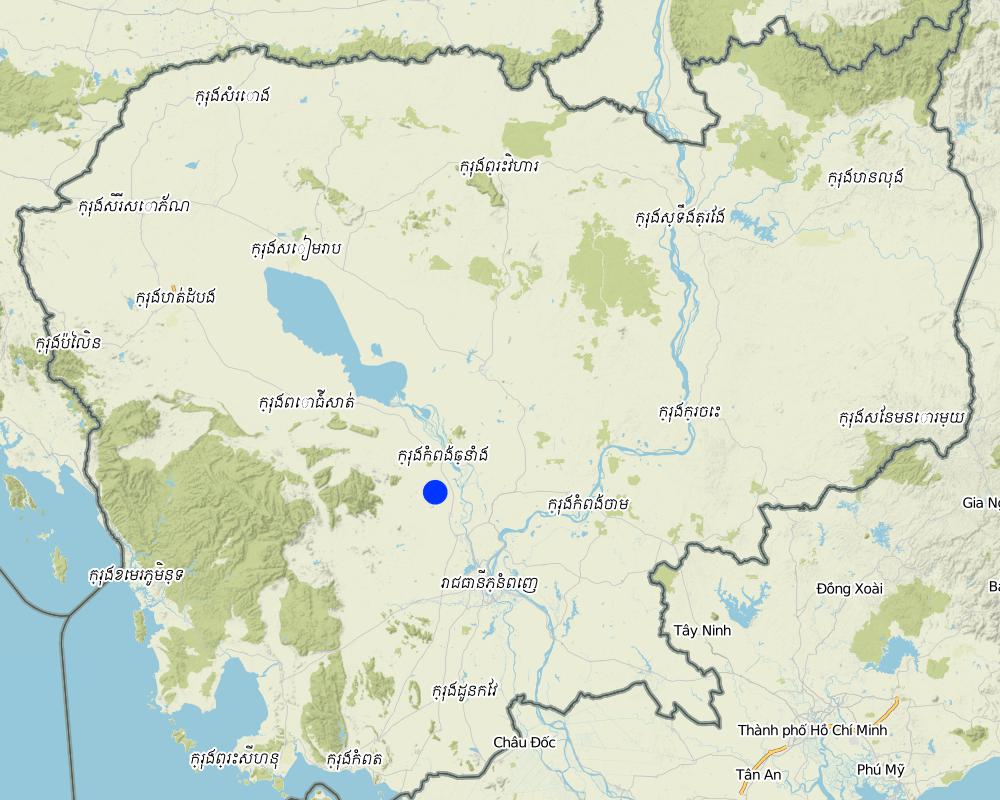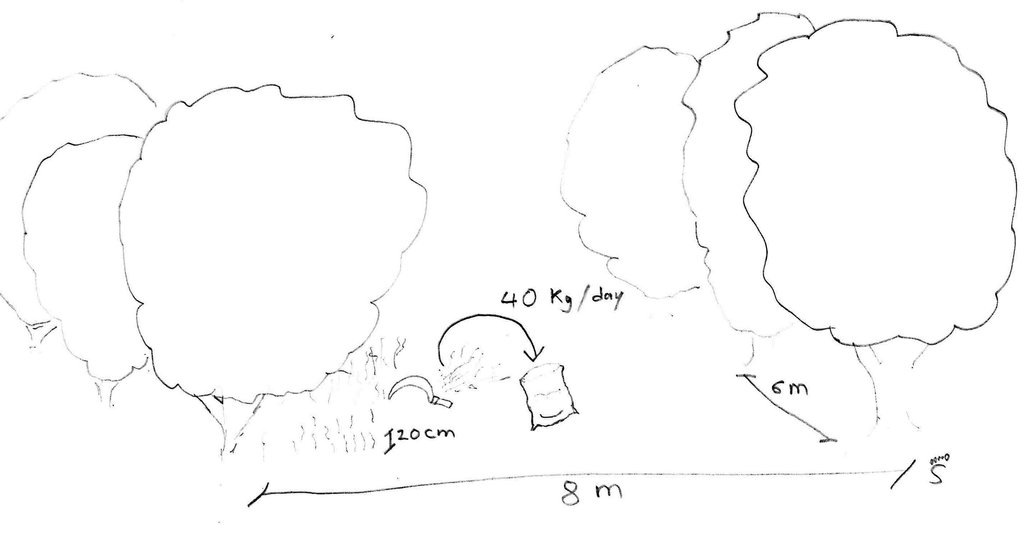Growing stylo grass (Stylosanthes guianensis) as cattle fodder between and under mango trees. [Camboja]
- Criação:
- Atualização:
- Compilador/a: Christoph Kaufmann
- Editor: –
- Revisores: Deborah Niggli, Alexandra Gavilano
ការដាំស្មៅជាចំណីសត្វ (Stylosanthes guianensis) ទៅតាមចន្លោះដើមស្វាយ (Khmer)
technologies_1642 - Camboja
Veja as seções
Expandir tudo Recolher tudo1. Informação geral
1.2 Detalhes do contato das pessoas capacitadas e instituições envolvidas na avaliação e documentação da tecnologia
1.3 Condições em relação ao uso da informação documentada através de WOCAT
O compilador e a(s) pessoa(s) capacitada(s) aceitam as condições relativas ao uso de dados documentados através do WOCAT:
Sim
1.4 Declaração de sustentabilidade da tecnologia descrita
A tecnologia descrita aqui é problemática em relação a degradação da terra de forma que não pode ser declarada uma tecnologia de gestão sustentável de terra?
Não
2. Descrição da tecnologia de GST
2.1 Descrição curta da tecnologia
Definição da tecnologia:
Stylo grass (Stylosanthes guianensis) is grown under and between mango trees to be used as fodder for cattle.
2.2 Descrição detalhada da tecnologia
Descrição:
Stylo grass (Stylosanthes guianensis, CV. Stylo 184) is a leguminous shrub which is used in pastures and as fodder crop. It is drought tolerant and can be harvested during the whole year, though it grows only when sufficient water is available. Mangos (Mangifera indica) are grown mainly from seeds in the area, either as single trees in home gardens or as orchards. The farmer of this case study has a mango orchard of 0.6 ha with trees spaced 6 by 8 meters, and grows stylo grass as a cover crop under and between the trees. Each day a patch of stylo grass is harvested by hand, and around 40 kg of this fodder is fed to the cattle together with rice straw. This allows the farmer to keep more cattle than before, 11 heads instead of 5. The mangos are mainly sold on the market, and some are dried. This agroforestry system reduces erosion by wind and water, as the soil is covered the whole year and the trees slow down the wind. The cattle can be kept near the house, which is good for making compost and biogas.
In 2004, the farmer cleared a forest and planted mango seedling. Between the mangos, he grew pumpkins, watermelons and cucumbers, but even though he used compost the soil fertility deteriorated fast and the cucurbits did not produce anymore. A local NGO, LAREC (Local Agricultural Research and Extension Centre), was looking for farmers with enough cattle and land in the area to try stylo grass, which was unknown in the area. The farmer, first reluctant because his other crops were not producing, started to plant stylo grass seeds he got from the NGO in July 2013 (information for this documentation was collected one year after the start).To do so, he plouwed and harrowed the fields with the hand tractor, and broadcasted the seeds by hand. After the first 3 months, during which he needed to weed, he started harvesting the fodder, and he cut 40 kg a day, one patch after another, 20 cm from the soil. This allows the reproduction of this cover crop.
The land user wants to expand his stylo grass to his other mango orchard, and is collecting seeds for this. Other farmers in the area are also interested in this technology; and the land user of this case-study starts to sell them stylo grass seeds but does not produce enough for all yet.
The analysed area is mostly flat (slope < 2%), tropic (dry and wet season), and the soils are mostly sandy or loamy. The soils contain little organic matter (low soil fertility, acidification, small amount of cattle, area has been deforested) and the groundwater table is rather high (3 m below soil level during the dry season, on the surface during the wet season).
Due to climate change, the rainfalls are more erratic, temperatures rise and droughts are more recurrent. Rice is the predominant crop grown in the area, since it serves as staple food (mix subsistence and commercial activities). Rice is often grown in monocultures and harvested once a year. Once the rice is harvested (dry season), some farmer release cattle to the paddy fields to eat the straw and weeds.
As an addition to rice, most land users grow vegetable and fruits in small home gardens (subsistence) and complement their income by producing handicrafts or through off farm income / remittances from family members working in other places. The increasing migration rate (the young generation leaves the villages to work in the cities, garment industry or abroad) results in a decrease of available labour force in the area which has detrimental effects on the agricultural activities. Furthermore, the civil war in the 1970s (Khmer Rouge) led to the loss of agricultural knowledge which different NGOs try to re-establish.
2.3 Fotos da tecnologia
2.5 País/região/locais onde a tecnologia foi aplicada e que estão cobertos nesta avaliação
País:
Camboja
Região/Estado/Província:
Kampong Chhnang
Especificação adicional de localização:
Sre Ouk Samlor Sap/Taing Krasaing/Rolear Pha,er
Especifique a difusão da tecnologia:
- Uniformemente difundida numa área
Se a Tecnologia estiver uniformemente distribuída por uma área, especifique a área coberta (em km2):
0,006
Se a área precisa não for conhecida, indicar a área aproximada coberta:
- < 0,1 km2 (10 ha)
Comentários:
0.6 ha
Map
×2.6 Data da implementação
Caso o ano exato seja desconhecido, indique a data aproximada:
- menos de 10 anos atrás (recentemente)
2.7 Introdução da tecnologia
Especifique como a tecnologia foi introduzida:
- através de projetos/intervenções externas
Comentários (tipos de projeto, etc.):
It started in July 2013 when SOFDEC gave stylo grass seeds to farmers with enough cattle and land
3. Classificação da tecnologia de GST
3.1 Principal/principais finalidade(s) da tecnologia
- Melhora a produção
- Reduz, previne, recupera a degradação do solo
3.2 Tipo(s) atualizado(s) de uso da terra onde a tecnologia foi aplicada
Uso do solo misturado dentro da mesma unidade de terra:
Sim
Especificar o uso misto da terra (culturas/ pastoreio/ árvores):
- Agrofloresta

Terra de cultivo
- Cultura anual
- Cultura de árvores e arbustos
Cultivo anual - Especificar culturas:
- culturas forrageiras - gramíneas
Cultivo de árvores e arbustos - Especificar culturas:
- manga, mangostão, goiaba
Número de estações de cultivo por ano:
- 1
Especifique:
Longest growing period in days: 210 Longest growing period from month to month: June-December
Comentários:
Major land use problems (compiler’s opinion): Lack of organic matter, lack of water retention in soil, irregularity of rainfall, low soil fertility (sandy soil), monocultures, bare soil during dry season.
Major land use problems (land users’ perception): Low soil fertility, lack of water, soil erosion by water on the slope.
3.3 O uso do solo mudou devido à implementação da Tecnologia?
O uso do solo mudou devido à implementação da Tecnologia?
- Sim (Por favor, preencha as perguntas abaixo com relação ao uso do solo antes da implementação da Tecnologia)

Terra de cultivo
- Cultura de árvores e arbustos
3.4 Abastecimento de água
Abastecimento de água para a terra na qual a tecnologia é aplicada:
- Precipitação natural
3.5 Grupo de GST ao qual pertence a tecnologia
- Agrofloresta
3.6 Medidas de GST contendo a tecnologia

Medidas vegetativas
- V2: gramíneas e plantas herbáceas perenes

Medidas de gestão
- M1: Mudança no tipo de uso da terra
Comentários:
Type of vegetative measures: aligned: -linear
3.7 Principais tipos de degradação da terra abordados pela tecnologia

Erosão do solo pela água
- Wt: Perda do solo superficial/erosão de superfície

Deteriorização química do solo
- Cn: declínio de fertilidade e teor reduzido de matéria orgânica (não causado pela erosão)

Degradação biológica
- Bc: redução da cobertura vegetal
- Bq: quantidade/ declínio da biomassa
Comentários:
Main causes of degradation: soil management (Soil left bare during the dry season.), deforestation / removal of natural vegetation (incl. forest fires) (Deforestation in 2004)
Secondary causes of degradation: population pressure (.New areas are deforested, and are degraded after a few years.), inputs and infrastructure: (roads, markets, distribution of water points, other, …) (Lack of irrigation.)
3.8 Redução, prevenção ou recuperação da degradação do solo
Especifique o objetivo da tecnologia em relação a degradação da terra:
- Reduzir a degradação do solo
- Recuperar/reabilitar solo severamente degradado
4. Especificações técnicas, implementação de atividades, entradas e custos
4.1 Desenho técnico da tecnologia
Especificações técnicas (relacionada ao desenho técnico):
Stylo grass is harvested daily between the mango trees, one patch after another. This allows different stages of growth.
Kampong Chhnang
Date: 2014
Technical knowledge required for field staff / advisors: low
Technical knowledge required for land users: low
Main technical functions: increase of biomass (quantity), promotion of vegetation species and varieties (quality, eg palatable fodder)
Secondary technical functions: improvement of ground cover, increase in nutrient availability (supply, recycling,…)
Aligned: -linear
Vegetative material: T : trees / shrubs
Number of plants per (ha): 200
Vertical interval between rows / strips / blocks (m): 8
Vertical interval within rows / strips / blocks (m): 6
Vegetative measure: Covering the soil
Vegetative measure: Vegetative material: G : grass
Trees/ shrubs species: Mangoes, Mangifera indica. Planted.
Grass species: Stylo grass, Stylosanthes guianensis. Seeded.
Autor:
Stefan Graf
4.2 Informação geral em relação ao cálculo de entradas e custos
Indique a média salarial da mão-de-obra contratada por dia:
5.00
4.3 Atividades de implantação
| Atividade | Periodicidade (estação do ano) | |
|---|---|---|
| 1. | Plow the field, dig holes and plant mango seedlings. | Once at the beginning of the wet season (May-June) |
| 2. | Sow stylo grass. | Once in July. |
| 3. | Weeding | first 3 months |
4.4 Custos e entradas necessárias para a implantação
| Especifique a entrada | Unidade | Quantidade | Custos por unidade | Custos totais por entrada | % dos custos arcados pelos usuários da terra | |
|---|---|---|---|---|---|---|
| Mão-de-obra | Labour | ha | 1,0 | 21,25 | 21,25 | 100,0 |
| Equipamento | machine use | ha | 1,0 | 100,0 | 100,0 | 100,0 |
| Material vegetal | seeds | ha | 1,0 | 8,0 | 8,0 | |
| Material vegetal | seedlings | ha | 1,0 | 200,0 | 200,0 | 100,0 |
| Fertilizantes e biocidas | fertilizer | ha | 1,0 | 28,0 | 28,0 | 100,0 |
| Custos totais para a implantação da tecnologia | 357,25 | |||||
| Custos totais para o estabelecimento da Tecnologia em USD | 357,25 | |||||
4.5 Atividades recorrentes/manutenção
| Atividade | Periodicidade/frequência | |
|---|---|---|
| 1. | Harvest 40 kg of stylo grass. | 1h/d |
| 2. | Harvest mangoes | April-May |
| 3. | Maintain the stylo grass, sowing bare spots | 2 person days per month |
4.6 Custos e entradas necessárias pata a manutenção/atividades recorrentes (por ano)
| Especifique a entrada | Unidade | Quantidade | Custos por unidade | Custos totais por entrada | % dos custos arcados pelos usuários da terra | |
|---|---|---|---|---|---|---|
| Mão-de-obra | Labour | ha | 1,0 | 590,0 | 590,0 | 100,0 |
| Custos totais para a manutenção da tecnologia | 590,0 | |||||
| Custos totais de manutenção da Tecnologia em USD | 590,0 | |||||
Comentários:
The costs were calculated in 2014 for an area of 0.6 ha. The farmer got 100’000 riel (25US$) for the 800 – 1000 kg mangoes produced, and a bag of fodder (40 kg, that he harvests each day on 0.6 ha) can be sold for around 5000 riel (1.25) on the market.
4.7 Fatores mais importantes que afetam os custos
Descreva os fatores mais determinantes que afetam os custos:
The costs were calculated as if he hired someone, and bought mango seedlings. As he did all of the work by himself, it was much cheaper. The most expensive is the harvesting of the fodder, but it should be taken into account that it is less labour intensive than harvesting wild grasses and cheaper than buying them.
5. Ambiente natural e humano
5.1 Clima
Precipitação pluviométrica anual
- <250 mm
- 251-500 mm
- 501-750 mm
- 751-1.000 mm
- 1.001-1.500 mm
- 1.501-2.000 mm
- 2.001-3.000 mm
- 3.001-4.000 mm
- > 4.000 mm
Especificações/comentários sobre a pluviosidade:
1486.45 mm 2013 in Kampong Chhnang
Zona agroclimática
- Subúmido
27° to 35°C
5.2 Topografia
Declividade média:
- Plano (0-2%)
- Suave ondulado (3-5%)
- Ondulado (6-10%)
- Moderadamente ondulado (11-15%)
- Forte ondulado (16-30%)
- Montanhoso (31-60%)
- Escarpado (>60%)
Formas de relevo:
- Planalto/planície
- Cumes
- Encosta de serra
- Encosta de morro
- Sopés
- Fundos de vale
Zona de altitude:
- 0-100 m s.n.m.
- 101-500 m s.n.m.
- 501-1.000 m s.n.m.
- 1.001-1.500 m s.n.m.
- 1.501-2.000 m s.n.m.
- 2.001-2.500 m s.n.m.
- 2.501-3.000 m s.n.m.
- 3.001-4.000 m s.n.m.
- > 4.000 m s.n.m.
5.3 Solos
Profundidade do solo em média:
- Muito raso (0-20 cm)
- Raso (21-50 cm)
- Moderadamente profundo (51-80 cm)
- Profundo (81-120 cm)
- Muito profundo (>120 cm)
Textura do solo (solo superficial):
- Grosso/fino (arenoso)
Matéria orgânica do solo superficial:
- Médio (1-3%)
- Baixo (<1%)
5.4 Disponibilidade e qualidade de água
Lençol freático:
< 5 m
Disponibilidade de água de superfície:
Precário/nenhum
Qualidade da água (não tratada):
Água potável precária (tratamento necessário)
Comentários e outras especificações sobre a qualidade e a quantidade da água:
availability of surface water poor durin dry seasons
5.5 Biodiversidade
Diversidade de espécies:
- Baixo
5.6 Características dos usuários da terra que utilizam a tecnologia
Sedentário ou nômade:
- Sedentário
Orientação de mercado do sistema de produção:
- misto (subsistência/comercial)
Rendimento não agrícola:
- 10-50% de toda renda
Nível relativo de riqueza:
- Rico
Indivíduos ou grupos:
- Indivíduo/unidade familiar
Nível de mecanização:
- Trabalho manual
- Mecanizado/motorizado
Gênero:
- Homens
Indique outras características relevantes dos usuários da terra:
Land users applying the Technology are mainly Leaders / privileged
Difference in the involvement of women and men: Only one man is applying the technology, his wife works in the garment industry.
Population density: 10-50 persons/km2
Annual population growth: 0.5% - 1%
Off-farm income specification: His wife works in a factory.
5.7 Área média de terrenos utilizados pelos usuários de terrenos que aplicam a Tecnologia
- < 0,5 ha
- 0,5-1 ha
- 1-2 ha
- 2-5 ha
- 5-15 ha
- 15-50 ha
- 50-100 ha
- 100-500 ha
- 500-1.000 ha
- 1.000-10.000 ha
- > 10.000 ha
É considerado pequena, média ou grande escala (referente ao contexto local)?
- Média escala
5.8 Propriedade de terra, direitos de uso da terra e de uso da água
Propriedade da terra:
- Comunitário/rural
- Indivíduo, não intitulado
Direitos do uso da terra:
- Comunitário (organizado)
- Indivíduo
Direitos do uso da água:
- Acesso livre (não organizado)
Comentários:
Land ownership is very complex. Most of the land belongs officially to the government, yet many land users hold a paper confirming they applied for a land title – but de iure, this paper is worthless.
5.9 Acesso a serviços e infraestrutura
Saúde:
- Pobre
- Moderado
- Bom
Educação:
- Pobre
- Moderado
- Bom
Assistência técnica:
- Pobre
- Moderado
- Bom
Emprego (p. ex. não agrícola):
- Pobre
- Moderado
- Bom
Mercados:
- Pobre
- Moderado
- Bom
Energia:
- Pobre
- Moderado
- Bom
Vias e transporte:
- Pobre
- Moderado
- Bom
Água potável e saneamento:
- Pobre
- Moderado
- Bom
Serviços financeiros:
- Pobre
- Moderado
- Bom
6. Impactos e declarações finais
6.1 Impactos no local mostrados pela tecnologia
Impactos socioeconômicos
Produção
Produção de forragens
Qualidade da forragem
Produção animal
Área de produção
Renda e custos
Diversidade de fontes de rendimento
Impactos socioculturais
Segurança alimentar/auto-suficiência
Contribution to human well-being
Comentários/especificar:
Less time needs to be invested in harvesting wild grasses.
Impactos ecológicos
Solo
Cobertura do solo
Perda de solo
Comentários/especificar:
No wind erosion because of the soil cover, less water erosion.
Ciclo e recarga de nutrientes
Comentários/especificar:
Stylo gras is a leguminous, thus fixes nitrogen.
Matéria orgânica do solo/carbono abaixo do solo
Comentários/especificar:
The mango leaves fall to the soil and increase the organic content.
Biodiversidade: vegetação, animais
Biomassa/carbono acima do solo
Clima e redução de riscos de desastre
Velocidade do vento
Comentários/especificar:
The mango trees slow down the wind
6.2 Impactos externos mostrados pela tecnologia
Sedimentação a jusante
Sedimentos transportados pelo vento
Fields need to be fenced because of the neighbour's cattle
Comentários/especificar:
The living fence was already planted before.
6.3 Exposição e sensibilidade da tecnologia às mudanças climáticas graduais e extremos/desastres relacionados ao clima (conforme o ponto de vista dos usuários da terra)
Mudança climática gradual
Mudança climática gradual
| Estação do ano | aumento ou diminuição | Como a tecnologia lida com isso? | |
|---|---|---|---|
| Temperatura anual | aumento | não conhecido |
Extremos (desastres) relacionados ao clima
Desastres meteorológicos
| Como a tecnologia lida com isso? | |
|---|---|
| Temporal local | bem |
| Tempestade de vento local | bem |
Desastres climatológicos
| Como a tecnologia lida com isso? | |
|---|---|
| Seca | bem |
Desastres hidrológicos
| Como a tecnologia lida com isso? | |
|---|---|
| Inundação geral (rio) | não conhecido |
Outras consequências relacionadas ao clima
Outras consequências relacionadas ao clima
| Como a tecnologia lida com isso? | |
|---|---|
| Período de crescimento reduzido | bem |
6.4 Análise do custo-benefício
Como os benefícios se comparam aos custos de implantação (do ponto de vista dos usuários da terra)?
Retornos a curto prazo:
negativo
Retornos a longo prazo:
positivo
Como os benefícios se comparam aos custos recorrentes/de manutenção(do ponto de vista dos usuários da terra)?
Retornos a curto prazo:
muito positivo
Retornos a longo prazo:
muito positivo
Comentários:
The maintenance costs consist mainly of harvesting, which is very positive.
6.5 Adoção da tecnologia
- > 50%
Se disponível, determine a quantidade (número de unidades familiares e/ou área abordada):
100% or 1 land user family
Comentários:
100% of land user families have adopted the Technology with external material support
1 land user families have adopted the Technology with external material support
Other farmers in this village want to grow stylo grass, but cannot get seeds. This farmer starts to sell seeds to other farmers.
Other farmers in this village want to grow stylo grass, but cannot get seeds. This farmer starts to sell seeds to other farmers.
There is a strong trend towards spontaneous adoption of the Technology
Other farmers in the village showed strong interest to start applying this technology. The farmer of this case study started to sell seeds to 3 of them, and 7 others in the area showed interest as well but there were not enough seeds available.
6.7 Pontos fortes/vantagens/oportunidades da tecnologia
| Pontos fortes/vantagens/oportunidades na visão do usuário da terra |
|---|
| As a leguminous, stylo grass could be plowed into the soil to improve the soil fertility. |
| Less time is needed to harvest fodder for the cattle, as he does not need to collect it from the wild anymore. |
| Pontos fortes/vantagens/oportunidades na visão do compilador ou de outra pessoa capacitada |
|---|
| As a leguminous, stylo grass has a high protein content, which makes it valuable as fodder. |
| The soil is covered, trees slow down the wind, inducing a good micro-climate and stopping wind erosion. |
| Water erosion on slopes is reduced as the stylo grass covers the soil. |
6.8 Pontos fracos, desvantagens/riscos da tecnologia e formas de superá-los
| Pontos fracos/desvantagens/riscos na visão do usuário da terra | Como eles podem ser superados? |
|---|---|
| The land has to be fenced off, as neighbours cattle otherwise graze in his fodder. | Living fence (currently used by the land users), needs only little maintenance. |
| Pontos fracos/vantagens/riscos na visão do compilador ou de outra pessoa capacitada | Como eles podem ser superados? |
|---|---|
| Productivity of the mangoes is mostly low as seedlings were used. | Learn how to graft, with improved varieties or selected individuals from the farm. The use of seedlings allows a selection of new varieties; the grafting can take place at any tree size. |
| The cultivar Stylo 184 has only a single-gene resistance to anthracnose (tropicalforage.info). In case of breakdown all the fodder is lost. | Mixed cropping with another fodder, or mixed cropping of different cultivars of Stylosanthes guianensis |
| Stylo grass is not considered shade tolerant (tropicalforages.info), when the mangoes will grow higher could become unproductive. | Use dwarf rootstocks for the mangoes, space them further apart, or use different species of fodder. |
7. Referências e links
7.1 Métodos/fontes de informação
- visitas de campo, pesquisas de campo
- entrevistas com usuários de terras
Quando os dados foram compilados (no campo)?
14/07/2014
7.2 Referências às publicações disponíveis
Título, autor, ano, ISBN:
Tropical forage info website. Stylosanthes guianensis
Disponível de onde? Custos?
http://www.tropicalforages.info/key/Forages/Media/Html/Stylosanthes_guianensis_var._guianensis.htm
Título, autor, ano, ISBN:
Feedipedia Website. Stylo (Stylosanthes guianensis)
Disponível de onde? Custos?
http://www.feedipedia.org/node/251
Links e módulos
Expandir tudo Recolher tudoLinks
Não há links
Módulos
Não há módulos


